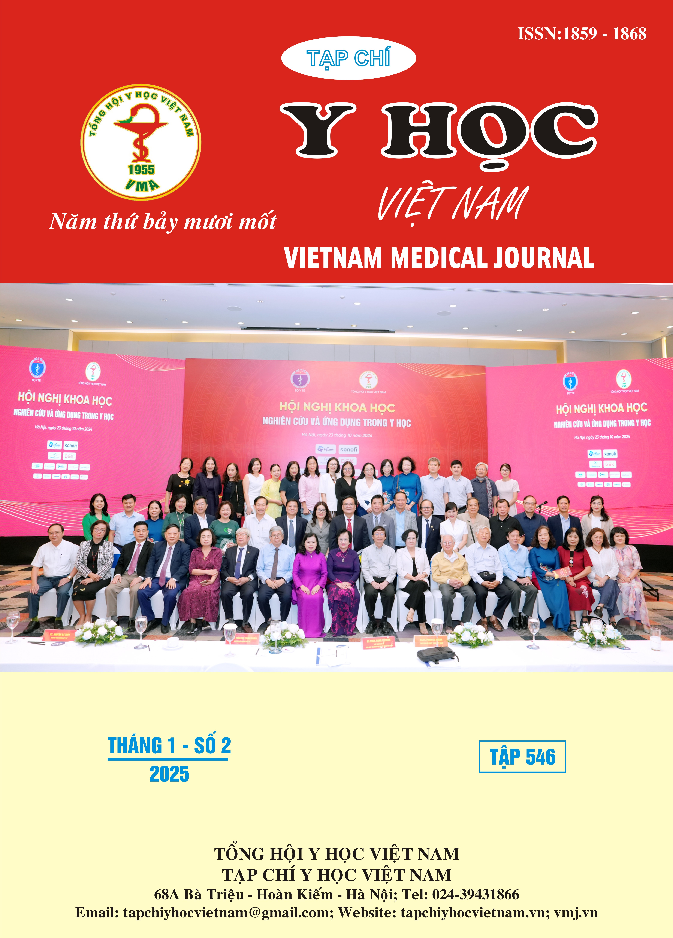CLINICAL FEATURES AND IMAGING DIAGNOSIS IN PATIENTS WITH THORACOLUMBAR VERTEBRAL COMPRESSION DUE TO KUMMELL’S DISEASE AT VIET DUC HOSPITAL
Main Article Content
Abstract
Objective: To describe the clinical and paraclinical characteristics of patients with thoractolumbar vertebral compression due to Kummell’s disease at Viet Duc University Hospital. Methods: A prospective descriptive study conducted on 27 patients with thoractolumbar vertebral compression due tho Kummell’s disease at Viet Duc University Hospital from January 2021 to January 2023. Results: Among the 27 patients in our study, the majority were female, accounting for 70.4%, with an average age of 58,6 ± 4,9 years. The clinical characteristics of the patients included an average VAS score of 7,4 ± 0,8, with 5 patients presenting with AIS D-level neurological injury, and an average ODI score of 67,2% ± 4,8%. On X-ray imaging: most patients had damage to a single vertebra (92,6%), with an average vertebral body compression angle of 29,2° ± 1,4°, and a regional kyphotic angle of 33,3° ± 1,8°, 100% of patients had intravertebral vacuum sign. The average T-score was 3,4 ± 0,5. On MRI: 77.8% of patients had vertebral body edema, 29.6% had spinal canal stenosis, and 18,5% had posterior ligamentous complex (PLC) injury, 100% of patients had intravertebral vacuum sign hyperintense on T2W and hypointense on T1W. Conclusion: The prominent clinical symptom of patients with vertebral compression due to Kummell's disease is spinal pain, which may be accompanied by neurological symptoms, primarily of mild to moderate severity. On X-rays, patients exhibit spinal kyphosis with an increased kyphotic angle and vertebral body collapse angle, along with a visible intravertebral vacuum sign. MRI may reveal damage to the posterior ligamentous complex (PLC), spinal cord edema, and a signal void within the vertebral body that appears hyperintense on T2W and hypointense on T1W.
Article Details
Keywords
Thoracolumbar spinal injury, osteoporosis, post-traumatic thoracolumbar kyphosis, Kummell’s disease
References
2. Kendler DL, Bauer DC, Davison KS, et al. Vertebral Fractures: Clinical Importance and Management. The American Journal of Medicine. 2016;129(2):221.e1-221.e10.
3. Baaj AA, Downes K, Vaccaro AR, Uribe JS, Vale FL. Trends in the treatment of lumbar spine fractures in the United States: a socioeconomics perspective: clinical article. J Neurosurg Spine. 2011;15(4):367-370.
4. Jo DJ, Kim YS, Kim SM, Kim KT, Seo EM. Clinical and radiological outcomes of modified posterior closing wedge osteotomy for the treatment of posttraumatic thoracolumbar kyphosis. J Neurosurg Spine. 2015;23(4):510-517.
5. Munting E. Surgical treatment of post-traumatic kyphosis in the thoracolumbar spine: indications and technical aspects. Eur Spine J. 2010;19 Suppl 1:S69-73.
6. Young WF, Brown D, Kendler A, Clements D. Delayed post-traumatic osteonecrosis of a vertebral body (Kummell's disease) Acta Orthop Belg. 2002;68(1):13–19. [PubMed] [Google Scholar]
7. Brower AC, Downey EF., Jr Kümmell disease: report of a case with serial radiographs. Radiology. 1981;141(2):363–364. [PubMed] [Google Scholar]
8. Yu CW, Hsu CY, Shih TT, Chen BB, Fu CJ. Vertebral osteonecrosis: MR imaging findings and related changes on adjacent levels. AJNR Am J Neuroradiol. 2007;28(1):42–47. [PMC free article] [PubMed] [Google Scholar]
9. Mirovsky Y, Anekstein Y, Shalmon E, Peer A. Vacuum clefts of the vertebral bodies. AJNR Am J Neuroradiol. 2005;26(7):1634–1640. [PMC free article] [PubMed] [Google Scholar]
10. Freedman BA, Heller JG. Kummel disease: a not-so-rare complication of osteoporotic vertebral compression fractures. J Am Board Fam Med. 2009;22(1):75–78. [PubMed] [Google Scholar]


